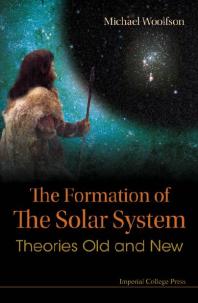书目详情:
ContentsIntroductionPrologue: The DreamerGeneral BackgroundChapter 1. Theories Come and Theories Go1.1 What is Science?1.2 The Problem of Cosmogony1.3 New Theories for OldChapter 2. Measuring Atoms and the Universe2.1 Measuring Things in Everyday Life2.2 Science and Everyday Life2.3 Small Things Beyond Our Ken2.4 Measuring Things in the Solar System2.5 Large Things Beyond Our KenEnlightenmentChapter 3. Greek O.erings3.1 Even Before the Ancient Greeks3.2 Plato and Aristotle3.3 Aristarchus — A Man Ahead of his Time3.4 Eratosthenes — The Man who Measured the Earth3.5 Ptolemy and the Geocentric Solar SystemChapter 4. The Shoulders of Giants4.1 The Refugees4.2 Nicolaus Copernicus and a Heliocentric Solar System4.3 Tycho Brahe — the Man with a Golden Nose4.4 Johannes Kepler — A Mathematical Genius4.5 Galileo Galilei — Observation versus Faith4.6 Isaac Newton — and All was LightThe Solar System: Features and ProblemsChapter 5. A Voyage of Discovery to the Solar System5.1 Travelling Towards the Solar System5.2 Approaching the Solar System5.3 Most of the Planets have Satellites5.4 Other Small BodiesChapter 6. The Problem to be Solved6.1 Knowledge and Time6.2 Very Basic Requirements for a SolutionChapter 7. The French Connection7.1 Some Early Theoretical and Observational Developments7.2 Laplace and his Spinning Cloud7.3 The Problem with a Spinning CloudChapter 8. American Catherine-Wheels8.1 Spirals in the Sky8.2 Making a Catherine Wheel8.3 Objections to the Chamberlin–Moulton TheoryChapter 9. British Big Tides9.1 The Jeans Tidal Theory9.2 Jeffreys’ Objections9.3 Russell’s Objection9.4 Spitzer’s Objection9.5 A Modern ObjectionChapter 10. Russian Cloud Capture — With British Help10.1 The Schmidt Model10.2 Lyttleton’s Modification of the Accretion TheoryChapter 11. German Vortices — With a Little French Help11.1 First Ideas about Vortices11.2 The von Weizs¨acker Vortex Theory11.3 Objections to the Vortex IdeaChapter 12. McCrea’s Floccules12.1 Producing Stars and Planets Together12.2 Objections to the Floccule TheoryChapter 13. What Earlier Theories Indicate13.1 Angular Momentum Difficulties13.2 Planet Formation13.3 Indications of Requirements for a Successful TheoryNew KnowledgeChapter 14. Disks Around New Stars14.1 How Hot and How Luminous?14.2 What is a New Star?14.3 Detecting DisksChapter 15. Planets Around Other Stars15.1 Stars in Orbit15.2 Finding the Speed of a Star15.3 Finding Out About the Planet15.4 Characteristics of ExoplanetsChapter 16. Disks Around Older Stars16.1 The Sun has a Disk16.2 Disks Around Other Older StarsChapter 17. What a Theory Should Explain Now17.1 The Beginning of the 21st Century17.2 The Sun and its Properties17.3 Planet Formation17.4 Satellite Formation17.5 Asteroids and Comets17.6 Concluding RemarksThe Return of the NebulaChapter 18. The New Solar Nebula Theory: The Angular Momentum Problem18.1 A Message from Meteorites18.2 Mechanical Slowing Down of the Sun’s Spin18.3 Magnetism Gives a Helping Hand18.4 A Modification of the Hoyle Mechanism18.5 Slowing the Sun’s SpinChapter 19. Making Planets Top-Down19.1 A Massive Disk19.2 Some Problems of Top-Down ProcessesChapter 20. A Bottom-Up Alternative20.1 A Summary of the Bottom-Up Approach20.2 Forming a Dusty Carpet20.3 The Formation of Planetesimals20.4 Making Terrestrial Planets and Cores for Giant Planets20.5 Major Planets — The Final StageChapter 21. Making Planets Faster21.1 Conditions in the Disk21.1.1. The initial masses of planetesimals21.1.2. Big bodies move more slowly21.1.3. Gas drag21.2 Runaway GrowthChapter 22. Wandering Planets22.1 The Need for Planets to Wander22.2 Interactions Between Planets22.3 Effects Due to the Mass of the Nebula Disk22.4 The Role of Spiral Waves22.5 Saving the Planet22.6 A Problem with Type-I MigrationChapter 23. Back to Top-Down23.1 Perceived Problems with the SNTMaking StarsChapter 24. This is the Stu. that Stars are Made of24.1 The Question24.2 The Galaxy24.3 The IngredientsChapter 25. Making Dense Cool Clouds25.1 The ISM, Clouds and Temperature25.2 Atoms, Ions, Molecules and Electrons25.3 Further Cooling Processes25.4 Making a Dense Cool CloudChapter 26. A Star is Born26.1 Collapse of Stout Party26.2 Turbulent Times26.3 The Big Squeeze26.4 Some Observations about Star Formation26.5 A Star-Forming ModelCaptureChapter 27. Close to the Maddening Crowd27.1 Neighbours27.2 Another Big SqueezeChapter 28. Close Encounters of the Stellar Kind28.1 Jeans Revisited — The Capture Theory28.2 New Knowledge — New Ideas28.3 A Method for Realistic Simulations28.4 Capture-Theory Simulations28.5 Doing Without ProtostarsChapter 29. Ever Decreasing Circles29.1 The Starting Orbits of Planets29.2 A Resisting Medium29.3 Resistance Due to Viscous Drag29.4 Resistance Due to the E.ects of Mass29.5 The Evolution of Planetary Orbits29.6 Slowing Down and Speeding Up29.7 Eccentric Orbits29.8 Orbital Periods in Simple RatiosChapter 30. How Many Planetary Systems?30.1 More About Embedded Clusters30.2 Factors to be Considered30.3 The Ravages of the Embedded ClusterChapter 31. Starting a Family31.2 The Family Circle or Disk)31.3 Other Features of the ModelChapter 32. Tilting — But not at Windmills32.1 The Leaning Sun32.2 A Child’s Top and Evolving Planetary Orbits32.3 The Leaning Planets32.4 A Fairly Close Encounter of the Protoplanet KindThe Biggish-Bang HypothesisChapter 33. The Terrestrial Planets Raise Problems!33.1 The Problem33.2 What Kinds of Material does the Universe Contain?33.3 What Kinds of Material Does the Earth Contain?Chapter 34. A Biggish Bang Theory: The Earth and Venus34.1 A Very Close Encounter of a Planetary Kind34.2 Hydrogen and Deuterium34.3 Deuterium in Early Planets34.4 How to Make a Hydrogen Bomb34.5 The Colliding Planets34.6 The Collision34.7 Summary and CommentsChapter 35. Behold the Wandering Moon35.1 Orphans of the Storm35.2 A Lopsided Moon35.3 The Lopsided Moon — An Answer and a Question35.4 Collision to the Rescue35.5 A Brief History of the MoonChapter 36. Fleet Mercury and Warlike Mars36.1 Mars as An Orphan36.2 Mercury as An OrphanChapter 37. Gods of the Sea and the Nether Regions37.1 That Puny Planet Pluto37.2 Neptune and its Family37.3 Yet Another Effect of the Collision37.4 A Summary of the Triton-Collision and its OutcomeChapter 38. Bits and Pieces38.1 The Gap and its Denizens38.2 Some Ideas on the Origin of Asteroids38.3 The Planetary Collision Again!38.4 How do we Interpret Meteorites?38.5 How do we Interpret Asteroids?38.6 A SummaryChapter 39. Comets — The Harbingers of Doom!39.1 Early Superstition39.2 What is a Comet?39.3 The Different Kinds of Comet Orbit39.4 Some Problems with Comets39.5 Yes, You Guessed It — The Planetary Collision AgainChapter 40. Making Atoms With a Biggish Bang40.1 Let’s Find Out More About Isotopes40.2 Isotopes in Meteorites40.2.1. The carbon anomaly40.2.2. The oxygen anomaly40.2.3. The magnesium anomaly40.2.4. The neon anomaly40.2.5. Hydrogen Isotopes40.3 For The Last Time — A Planetary Collision40.4 Deuterium in the Colliding Planets and Other BodiesChapter 41. Is the Capture Theory Valid?Epilogue — An Autumn EveningBibliographyIndex
评论:







